by Barbara Illi
Institute of Molecular Biology and Pathology, National Research Council (IBPM-CNR), c/o Department of Biology and Biotechnology «Charles Darwin», Sapienza University, Rome, Italy
Table of Contents
- Introduction
- CoVs RNA synthesis
- SARS-CoV2 RNA-dependent-RNA polymerase (RdRp): a Jumping Jack Flash
- Matters are even more complicated: RNA modifications
- Conclusions
For non-expert
References
Introduction
The emergence of the 2019 novel Cororonavirus outbreak (2019-nCoV), actually renamed Severe Acute Respiratory Syndrome Coronavirus-2 (SARS-CoV-2), during 2019 December, still represents a big challenge for the scientific community. An enormous effort is ongoing to provide the highest number of information in the smallest fraction of time and, indeed, since January 2020, about 10 000 papers have been published to date.
Other Coronavirus outbreaks have spread in the last 17 years, SARS and Middle East Respiratory Syndrome (MERS) in 2003 and 2012, respectively, but they have been so efficiently controlled that the produced vaccines have been useless1,2. SARS-CoV-2 (hereafter simply CoV-2) is about 80% identical to its brother SARS-CoV. They also share several biological features, including the mechanism and proteins they use to entry host cells.
CoV-2 replication and transcription processes seem common to all Coronaviruses. Therefore, why CoV-2 has striking differences in epidemiological and clinical manifestations with respect to other human CoVs? To answer these questions, we have to step back to CoVs replication and transcriptional mechanisms.
CoVs RNA Synthesis
Coronaviruses allocate the largest RNA genome—about 30 kilobases—among all RNA viruses. As soon as the virus enter the host cell, its genome is immediately translated—by using ribosomes and specific proteins of the host cell—into a major polyprotein (pp1ab), encoded by the replicase gene (Figure 1), starting from two Open Reading Frames (ORF1a and ORF 1b), which are genomic regions capable to be translated into proteins. Pp1ab is cleaved into 16 non-structural proteins (nps 1–16; Figure 1)3,4 . Of note, two of the first translated nps—nps 3 and 5—possess the cleavage activity to cut pp1ab. These 16 nps are employed both for the replication of the entire viral genome (gRNA) and for the production of each viral mRNA (subgenomic RNAs, sgRNAs). Downstream the replicase gene, are the genes encoding the structural proteins—Spike (S), Envelope (E), Membrane (M), Nucleocapsid (N)—which pack the copied gRNA, leading to the assembly of progeny virions (Figure 1), and accessory proteins, whose role is still largely unknown (Figure 1)5.
Figure 1 Structure of SARS-CoV-2 genome
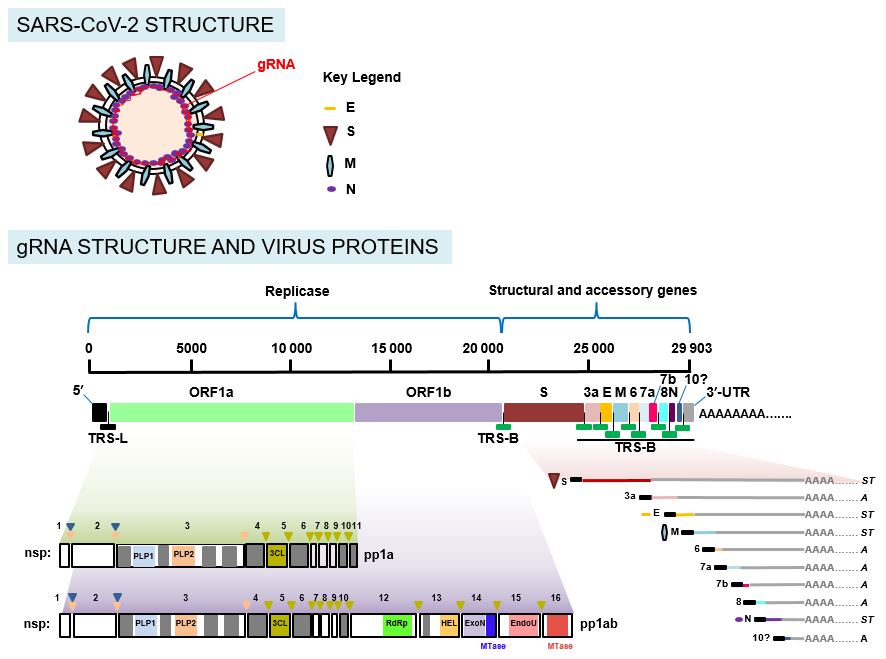
Most of the genome is occupied by the replicase gene, encoding for 16 nps by the polyprotein pp1ab. Downstream, structural and accessory genes are depicted. Abbreviations: L = Leader sequence; TRS-L = Transcription Regulatory Sequence-Leader; TRS-B = Transcription Regulatory Sequence-Body; ORF1a = Open Reading Frame 1a; ORF1b = Open Reading Frame 1b; S = Spike gene; E = Envelope gene; M = Membrane gene; N = Nucleocapsid gene. 3a, 6, 7a, 7b, 8, 10 = accessory genes; nsp=non structural protein; PLP = Papain-Like Protease; 3CL = 3C-like protease; RdRp = RNA-dependent RNA polymerase; HEL = Helicase; ExoN = Exonuclease; EndoU = Endonuclease; MTase = Methyltransferase; UTR = Untranslated region; ST= Structural protein; A = accessory protein. [Based upon Kim et al., Cell, 2020 and Sola et al., Ann Rev Virol, 2015]
Coronavirus RNA is basically a long messenger RNA (mRNA). Therefore, it is a positive strand, with a 5′→3′ sense (Figure 2A). RNA replication, that is the production of several copies of the viral genome, is a continuous synthesis. The new gRNA is produced by a negative intermediate, which represent the template for the positive gRNA (Figure 2A). This process involves mainly nsp12, which encode the RNA-dependent RNA polymerase (RdRp), which binds to the 3′ end of gRNA, across specific RNA sequences and structures, which may flex gRNA to promote replication (Figure 2B).
Figure 2 SARS-CoV-2 RNA replication
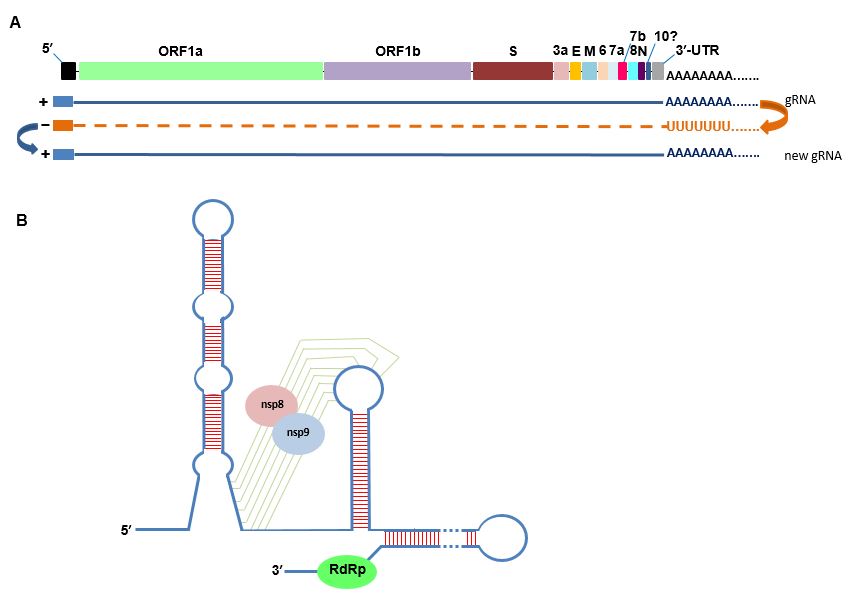
A Continuous RNA synthesis, using a negative RNA strand as template. B Example of RNA secondary structure, mediated by nsp8 and 9, which permits RdRp binding at the 3’ end and the production of minus-strand RNA. [Based upon Kim et al., Cell, 2020 and Sola et al, RNA Biol, 2011]
On the contrary, transcription, that is the synthesis of sgRNA, is a discontinuous process. Each sgRNA has a common sequence at the 5′ end of 70 nucleotides, which is present only once at the 5′ end of gRNA, called Leader (L). The discontinuous sgRNA synthesis relies on the presence of small stretch of nt, named transcription regulatory sequences (TRS), which are present downstream to the leader at the 5′ end (TRS-L) and preceding each sgRNA in the body of the genome (TRS-B, Figure 1). TRSs are characterized by a conserved sequence (CS) which is identical for the Leader (CS-L) and for each TRS-B (CS-B) and which permits the pairing of CS-L with the nascent negative RNA intermediate which is complementary to the CS-B when the RNA bends over to move the complementary CS-B (cCS-B) to the CS-L (Figure 3A), aligning TRS-L and each TRS-B3,4.
This process allows the discontinuous transcription of each sgRNA, leading to Leader-body fusions and requiring long distance RNA-RNA interactions, mediated by protein-RNA complexes. An example of this mechanism is shown in Figure 3B.
Figure 3 SARS-CoV-2 discontinuous RNA synthesis
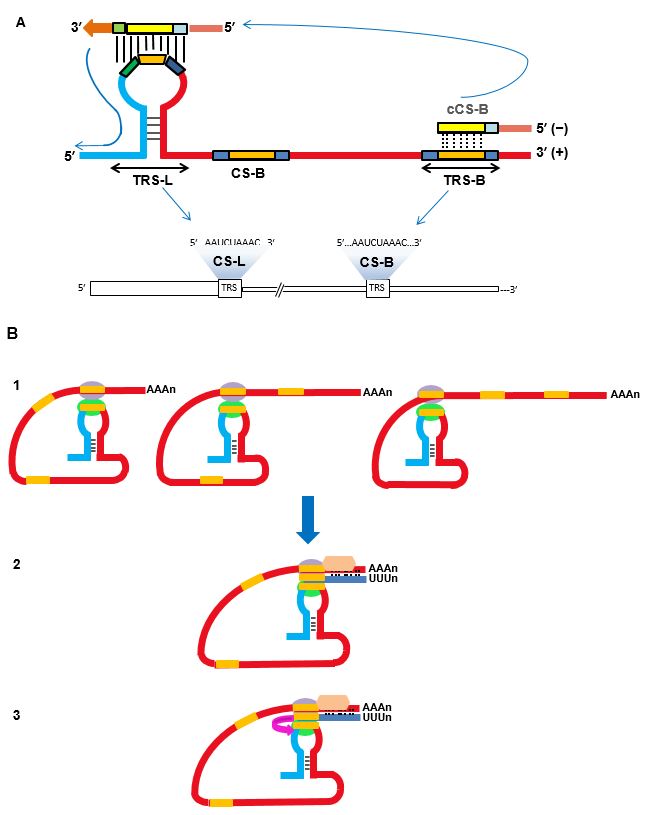
A Discontinuous transcription starts at each TRS-B of sgRNA which contains a small identical sequence to TRS-L (CS). This allows the switch (see also panel B) and pairing of the complimentary CS-B (cCS-B) to the CS-L to produce minus-strand sgRNAs from the Leader. B A three-step model for discontinuous RNA transcription. 1. Proteins, depicted as circles, bind to the TRS-L and to the CS (orange), both of the TRS-L and TRS-B, bringing TRS-L and TRS-B into proximity. 2. Once a “minus TRS-B” has been produced (rectangle in blue), by RdRp (pink hexagon), this “switches” to TRS-L adding a negative copy of TRS-L completing the negative strand of sgRNA, which will serve as template for the positive, encoding, sgRNA. [Adapted from Sola et al., Ann Rev Virol, 2015]
SARS-CoV2 RNA-dependent-RNA polymerase (RdRp): a Jumping Jack Flash
CoV-2 RNA synthesis is almost identical to that of other CoVs. However, some features of some of its sgRNAs suggest alternate mechanisms. Interestingly, CoV-2 whole panel of sgRNAs (i.e. the transcriptome) is expressed to a percentage higher than the transcriptome of the host cell, as if this latter is turned-off (Figure 4)6.
92% of viral sgRNAs are produced according to the mechanism described in the previous paragraph, and are mainly represented by 9 sgRNAs: N, S, M, E, 3a, 6, 7a, 7b and 8 (Figure 5A), but a number of them are unusual (Figure 5B).
Short sequences (3–4 nt) common to the 5′ and 3′ sites of the junction of these fusions suggests RdRp “jumping” from a donor to an acceptor RNA (Figure 6), a mechanism already described in other systems.
Figure 4 RNAs within infected cells
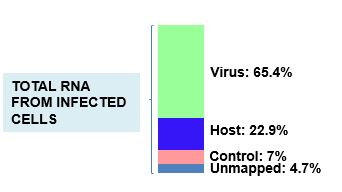
65.4% of the RNAs within infected cells belongs to CoV-2. [Based upon Kim et al., Cell, 2020]
Figure 5 SARS-CoV-2 RNA products
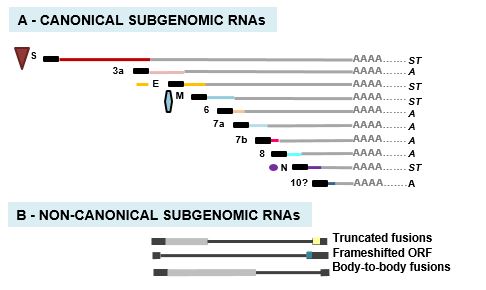
Canonical sgRNAs are shown together with unususal transcripts, highlighted by a red box. [Based upon Kim et al., Cell, 2020]
Figure 6 An example of mechanism of RdRp jumping.

RNA polymerase “jumps” from the 3′ site of a RNA donor—derived minus—strand RNA to the 3′ of an acceptor RNA, by the pairing of complimentary short sequences. [Based upon Kim et al., Cell, 2020]
This produces a number of sgRNAs with unknown functions in the viral life cycle, but some of them have the potential to produce protein products at a comparable quantity levels of accessory proteins. Therefore, it will be important to verify whether these proteins are effectively produced and which is their role.
Matters are even more complicated: RNA modifications
Well known epigenetic modifications affect DNA and associated histone proteins (constituting the chromatin, then chromosomes within the cells). Also RNA may be susceptible of epigenetic modifications and, indeed, some chemical RNA modifications have been detected in viral RNAs. These modifications may be due to the addition of chemical groups (as a methyl group on cytosine and adenine), addition of nucleotides (such as uracyl containing nt), loss of amino groups from bases. In CoV-2 RNA modifications have been found, but their nature has not been yet identified nor their function (Figure 7). However, it may be supposed that these modifications may regulate RNA stability or may contribute to evade host immune response.
Figure 7 CoV-2 RNA modifications
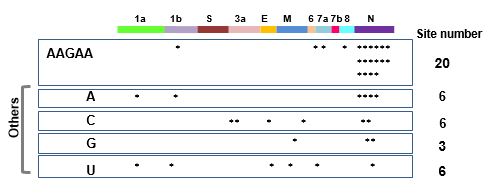
Several RNA modifications are shown as asterisks. The highest number occur at the sequence similar to AAGAA. The number of modifications across the gRNA of CoV-2 is shown at right. [Based upon Kim et al., Cell, 2020]
Conclusions
SARS-CoV-2 RNA biology is very similar to that of other CoVs. Nevertheless its RNA synthesis process is highly complex and, in some cases, escapes canonical mechanisms. Specifically, the high frequency of unusual fusions may produce viral variants, an issue which deserves a special attention, in light of drugs resistance or immune response evasion mechanisms CoV-2 may adopt to survive and propagate. RNA modifications may also play a role. These features have to be studied in animal tissues, where an immune system is active and responding. Furthermore, it will be interesting to evaluate whether CoV-2 RNA modifications are present in other CoVs, to better understand CoV-2 biology.
For non-expert
RNA
As well as DNA, RNA is constituted by “bricks” called nucleotides (nt). The genetic information in both DNA and RNA is included in a sequence of “letters”, which are represented by the bases within the nucleotides and which for RNA are: adenine (A), guanine (G), cytosine (C) and uracyl (U). Different combinations of these four letters constitute different instructions for the synthesis of all protein products. This is true for higher organisms, as well as for microorganisms, such as bacteria and viruses.
Epigenetics
Epigenetics is a scientific field which studies the reactions of a genome to a variety of stimuli, which may be environemental, intracellular, mechanical etc. Epigenetic modifications are hallmarks of these responses and, to make things as clear as possible, are chemical modifications of genomes and even proteins. These modifications are carried by multiproteins called epigenetic machineries, which are activated by the above mentioned stimuli. Epigenetic modifications change the characteristics of a genome, for example, indicating which genes have to be turned on or off to make the cell able to respond rapidly and efficiently to external or internal inputs.
References
- Lin, J. T. et al. Safety and immunogenicity from a phase I trial of inactivated severe acute respiratory syndrome coronavirus vaccine. Antivir Ther 12, 1107-1113 (2007).
- Yong, C. Y., Ong, H. K., Yeap, S. K., Ho, K. L. & Tan, W. S. Recent Advances in the Vaccine Development Against Middle East Respiratory Syndrome-Coronavirus. Front Microbiol 10, 1781, doi:10.3389/fmicb.2019.01781 (2019).
- Snijder, E. J., Decroly, E. & Ziebuhr, J. The Nonstructural Proteins Directing Coronavirus RNA Synthesis and Processing. Adv Virus Res 96, 59-126, doi:10.1016/bs.aivir.2016.08.008 (2016).
- Sola, I., Almazan, F., Zuniga, S. & Enjuanes, L. Continuous and Discontinuous RNA Synthesis in Coronaviruses. Annu Rev Virol 2, 265-288, doi:10.1146/annurev-virology-100114-055218 (2015).
- Masters, P. S. The molecular biology of coronaviruses. Adv Virus Res 66, 193-292, doi:10.1016/S0065-3527(06)66005-3 (2006).
- Kim, D. et al. The Architecture of SARS-CoV-2 Transcriptome. Cell 181, 914-921 e910, doi:10.1016/j.cell.2020.04.011 (2020).



 Scarica il PDF dell'articolo
Scarica il PDF dell'articolo
Commenti